-
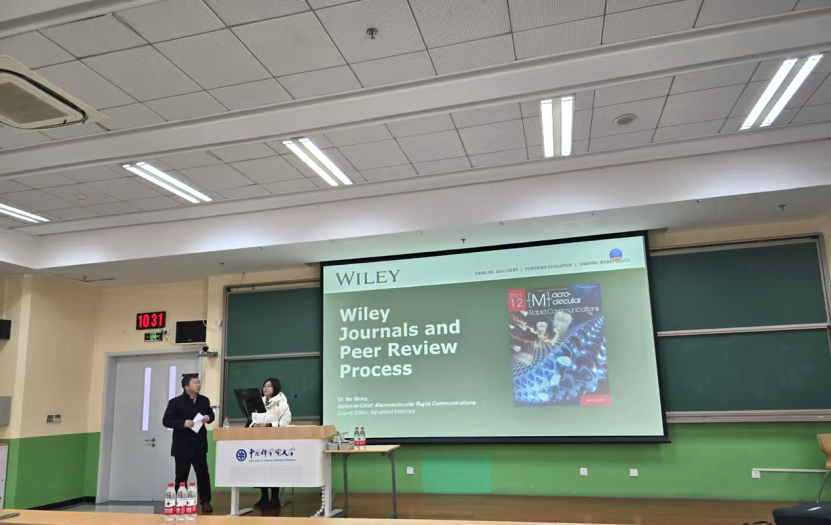 Lecture by Dr. Bo Weng on “How to Publish Academic Papers More Effectively”
Lecture by Dr. Bo Weng on “How to Publish Academic Papers More Effectively”On November 27, 2024, at 10:30 a.m., Dr. Bo Weng, Editor-in-Chief of journals under Wiley Group, was invited by Prof. Hui Huang from the School of Materials Science and Optoelectronic Technology to deliver a lecture titled “How to Publish Academic Papers More Effectively” at Room 107, Building 1, Yanqihu Campus, University of Chinese Academy of Sciences (UCAS).

Dr. Bo Weng graduated from Beijing University of Aeronautics and Astronautics (BUAA) in 2006 with a B.S. degree in Materials Science and Engineering. She obtained her Ph.D. in Chemistry from the University of Wollongong (UOW), Australia, in December 2012. Dr. Weng joined Wiley in October 2016 and is currently the Editor-in-Chief of Macromolecular Rapid Communications and Associate Editor of Advanced Materials.
During the lecture, Dr. Weng provided an in-depth overview of the development history of Wiley Publishing Group, and highlighted its impact on the global academic community, and demonstrated the cooperation between Wiley Group and domestic universities and research institutes. She then analyzed the key aspects of article writing, such as abstract, keywords, graphical design and conclusion. She explained in detail the primary concerns of journal editors when reviewing manuscripts, emphasizing that in today’s highly active research environment, editors process a large volume of submissions daily. Therefore, the clarity and conciseness of the abstract, the intuitive design of graphs and charts, and the timeliness of literature citations are crucial factors influencing an article’s acceptance.
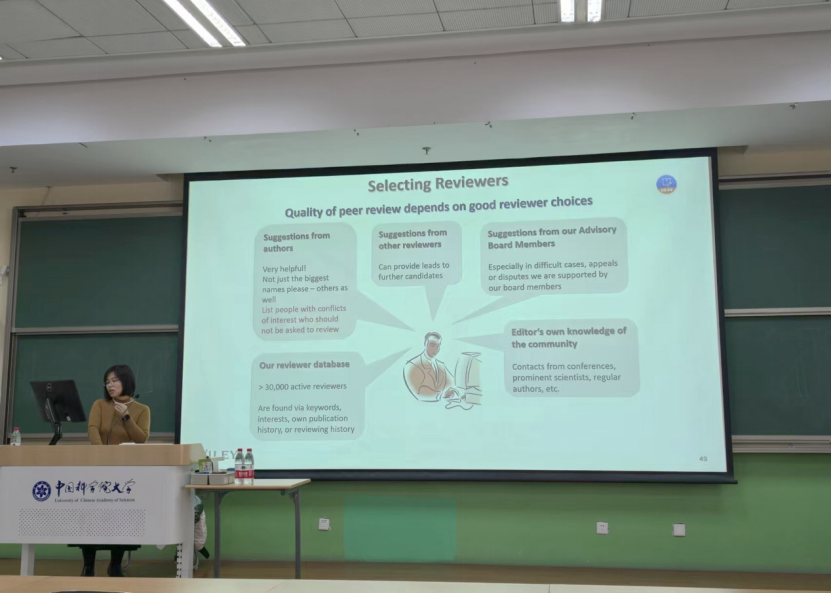
In addition, Dr. Weng discussed the critical steps in the submission process, including how to write an effective cover letter, how to select suitable reviewers, how to address reviewers’ comments, and the responsibilities of authors after their articles are published. At the end of the lecture, students and faculty members asked questions about manuscript submission and research issues, and Dr. Weng gave in-depth answers based on her own experience and had a lively discussion with the participants.
Dr. Weng's lecture not only enhanced participants' understanding of Wiley Group, but also provided valuable guidance and inspiration for researchers in their academic writing and publication endeavors.
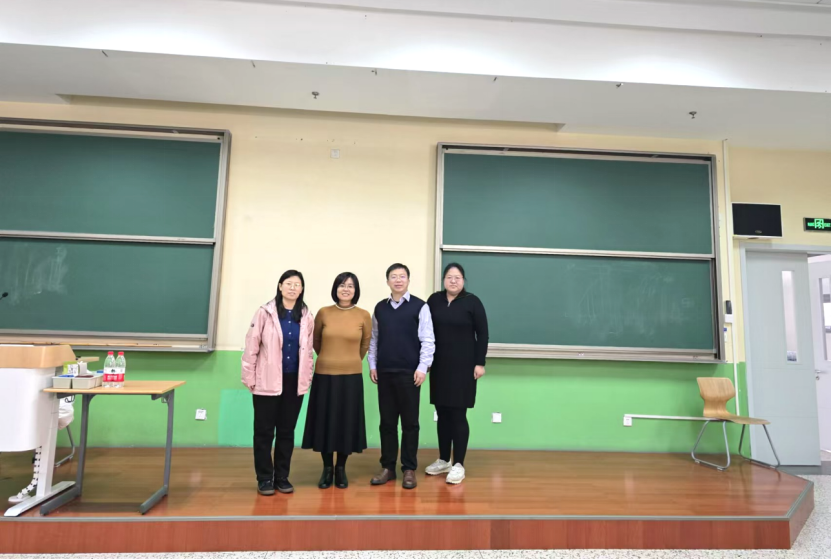
-
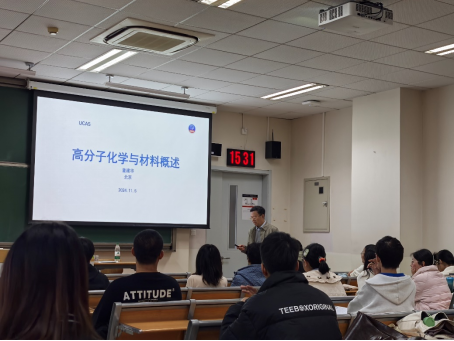 Researcher Dong Jianhua gave a lecture on the theme of "Overview of Polymer Chemistry and Materials"
Researcher Dong Jianhua gave a lecture on the theme of "Overview of Polymer Chemistry and Materials"On November 5, 2024, at 15:30 pm, researcher Dong Jianhua from the National Natural Science Foundation of China came to the University of Chinese Academy of Sciences at the invitation of Professor Huang Hui to give a lecture on the theme of "Overview of Polymer Chemistry and Materials", which was held in room 214 of the Teaching Building 1.

Prof. Dong Jianhua graduated from the Department of Chemistry of Zhejiang University in 1982 and received his Ph.D. degree from the Institute of Chemistry, Chinese Academy of Sciences in 1989. After two years of postdoctoral research in the Department of Chemistry of Peking University, he stayed on as a professor until December 1997. From 1998 to 2019, he was responsible for project management in the field of organic polymers at the National Natural Science Foundation of China (retired in June 2019). Since 1999, he has been a researcher, and has successively served as the project director, director of the science department, and second-level researcher in organic polymer materials, polymer science, materials chemistry and energy chemistry. It has organized many academic activities on the development of disciplines in the field of organic polymers and the strategic discussion of discipline frontiers, and the establishment of major research topics and operation management. He has published more than 50 academic papers and more than 30 review papers on scientific research management and academic progress. Editor-in-chief of three monographs on the frontiers, progress and prospects of the discipline; He has written several chapters for related monographs. He served as the 26th director of the Chinese Chemical Society, the executive director of the 28th and 29th councils, and served as the deputy director of the polymer discipline committee for a long time. He served as the deputy editor-in-chief of the Editorial Board of the Polymer Field of the third edition of the Encyclopedia of China, and organized and wrote scientific dictionaries and discipline strategy reports for many times. Since 2007, he has served as the associate editor of the international academic professional journals "Advanced Technology Polymers" and "Polymers for Advanced Technologies" of Wiley Publishing Company. Since 2011, he has been a member of the editorial board of the "Royal Society of Chemistry Polymer Chemistry Series". He has served as an editorial board member of many academic journals in China.
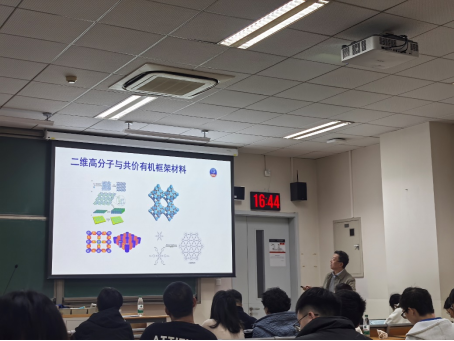
The lecture started from the milestone of the development of polymer chemistry, mainly expounded the mainstream and development trend of polymer scientific research, and focused on the wide application of polymer materials in people's clothing, food, housing and transportation, such as polymer drugs, degradable materials, etc. At the same time, several frontier directions and the latest progress in the field of polymers are introduced, such as COFs, two-dimensional monolayer polymeric fullerene materials, polymerized C60 multilayer molecular layers, polytelloxane-non-carbon backbone polymers, polycarbonylone and other new structural polymer materials. The enthusiastic sharing of researcher Dong Jianhua gave the teachers and students who participated in the lecture a deeper understanding of the polymer field and provided accurate guidance for them to conduct polymer research. Finally, Prof. Dong communicated and discussed with the teachers and students on the spot, and received a warm response.
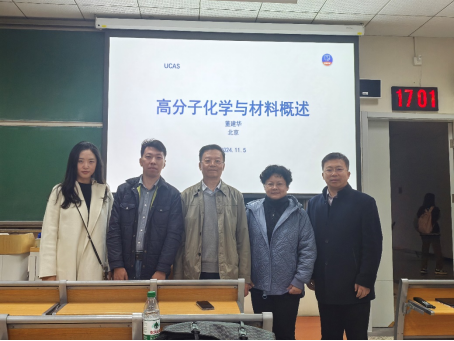
-
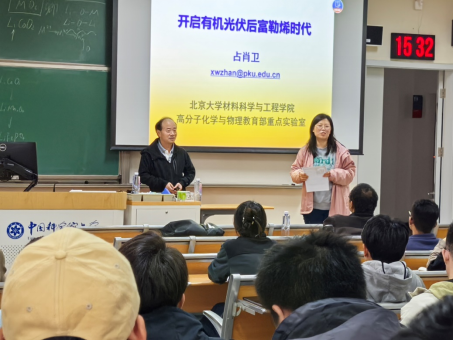 Professor Zhan Xiaowei's lecture on "Opening the Post-Fullerene Era of Organic Photovoltaics"
Professor Zhan Xiaowei's lecture on "Opening the Post-Fullerene Era of Organic Photovoltaics"At 15:30 p.m. on October 31, 2024, Professor Zhan Xiaowei from the School of Engineering/School of Materials Science of Peking University was invited by Professor Huang Hui and Shi Qinqin to give a lecture on the theme of "Opening the Post-Fullerene Era of Organic Photovoltaics", which was held in room 214 of the Teaching Building 1.

Zhan Xiaowei is a Boya Distinguished Professor of Peking University, a recipient of the National Science Foundation for Distinguished Young Scholars, a Fellow of the Chinese Chemical Society, and a Fellow of the Royal Society of Chemistry. 1986-1990, B.S., Department of Chemistry, Zhejiang University. 1993-1998, Ph.D., Department of Polymers, Zhejiang University. 1998-2002, Postdoctoral Fellow, Institute of Chemistry, Chinese Academy of Sciences. 1999, Visiting Scholar, Department of Chemistry, Hong Kong University of Science and Technology. 2002-2006, Research Associate/Research Scientist, Department of Chemistry, University of Arizona/Georgia Tech, USA. 2006-2012, Researcher, Institute of Chemistry, Chinese Academy of Sciences. 2012-present, Professor, School of Engineering/School of Materials, Peking University. He has been engaged in the research of organic polymer optoelectronic functional materials and devices for a long time, and has published more than 390 papers in journals such as Nature, which have been cited more than 56,000 times, and has been continuously selected as a global highly cited researcher since 2017. He has won the first prize of the Natural Science Award of the Ministry of Education and the second prize of the Beijing Natural Science Award (both of which are the first completers), the Youth Chemistry Award of the Chinese Chemical Society, the Honorary Award of the Polymer Science Invitation Report of the Chinese Chemical Society, the Outstanding Final Evaluation of the Hundred Talents Program of the Chinese Academy of Sciences, and the Outstanding Graduate Supervisor of the Chinese Academy of Sciences. He serves as a scientific editor/associate editor of Journal of Materials Chemistry A/C, and an editorial board/advisory editorial board member of 10 journals including ACS Energy Letters, Materials Horizons and Aggregate.

From 1995 to 2015, fullerenes have been dominating the electron acceptor materials in the field of organic photovoltaics, so these 20 years are called the "fullerene era". However, fullerenes have weak absorption in the visible region, large energy loss, and device efficiency has touched the ceiling. In addition, fullerene spherical molecules are easy to aggregate, the morphological stability is poor, and the lifetime of the device is limited. In response to the above problems, Professor Zhan introduced the "star molecule" ITIC invented by his team, which is known as a "milestone" and "epoch-making", which created a high-performance novel receptor system of "fused ring electron acceptor", opened the "post-fullerene era" in the field, broke through the bottleneck of organic photovoltaics, achieved a leap in device efficiency, and brought unprecedented new opportunities for the development of the field.

After that, Professor Zhan vividly introduced the application and future development direction of fused ring electron acceptor materials in the fields of organic/perovskite/quantum dot solar cells, photohydrolysis, field-effect transistors, photodetectors, light-emitting diodes, two-photon absorption, photothermal/ photoacoustic/photodynamic therapy, etc. He encouraged the students to look at scientific research from a long-term and scientific perspective, to carry out self-revolution from time to time, to persevere, and to be down-to-earth. Finally, the professor had an exchange and discussion with the teachers and students on the spot, and received a warm response from the teachers and students on the spot.
-
 Lecture on "Transport Mechanisms and Thermoelectric Performance Regulation of Organic Materials" by Researcher Zhu Jia
Lecture on "Transport Mechanisms and Thermoelectric Performance Regulation of Organic Materials" by Researcher Zhu JiaOn the afternoon of October 22, 2024, at 15:30, Researcher Zhu Jia from the National Center for Nanoscience, upon the invitation of Professor Huang Hui, delivered a lecture titled "Transport Mechanisms and Thermoelectric Performance Regulation of Organic Materials" at University of Chinese Academy of Sciences. The lecture was held in Classroom 214 of the Teaching Building 1.

About Zhu Jia: Zhu Jia is a researcher at the National Center for Nanoscience and Technology, a Ph.D. supervisor, and a member of the Organic Solids Professional Committee of the Chinese Chemical Society. From 2009 to 2021, he served as an associate professor at the College of Chemistry at Beijing Normal University, and in 2021, he joined the National Center for Nanoscience and Technology. His main research focuses on the electronic properties and processes of organic solid/semiconductor materials systems, as well as predicting the conductive and thermoelectric performance of molecular devices. He has established an integrated research model combining theoretical calculations, experimental validation, and device applications. In recent years, he has published over 80 research papers (SCI) as a corresponding author in top journals such as Nature Chemistry, Nature Communications, JACS, Angewandte Chemie, and Advanced Materials. He has also led and participated in several key projects, including the National Natural Science Foundation's Youth Fund, General Program, and the Ministry of Science and Technology's 973 Program.
The lecture began by introducing the concepts and key models of the field of organic solids, explaining the main research objects and characteristics of the organic solid discipline. Zhu Jia vividly illustrated the profound implications and practical significance of organic solids by quoting Academician Qian Renyuan's insights into organic solid. Organic solid science, one of the foundational fields in energy, information, and flexible materials, has significantly contributed to the advancement of modern technology through the development of advanced materials, green energy, electronic devices, and biomedical technologies. Hence, this discipline will be an essential theoretical and experimental foundation for the future development of new functional materials.
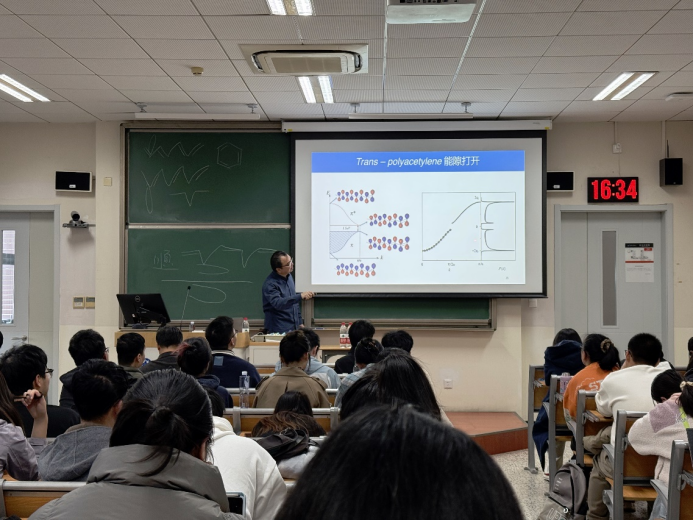
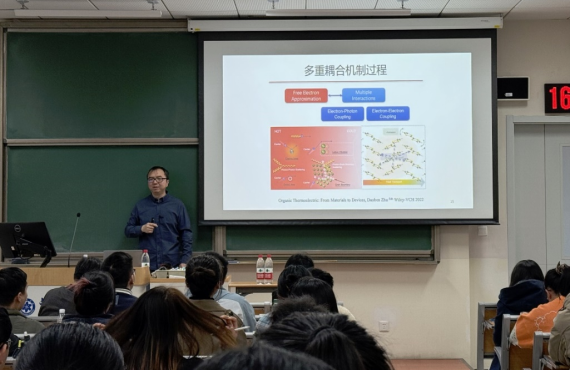
Zhu then presented first-principles calculations and experimental validations, applying Boltzmann transport theory and deformation potential theory to analyze various molecular structures and their aggregation states under non-doping conditions. He discussed the charge transport mechanism of Donor-Acceptor type charge-transfer complexes and changes in Seebeck values, predicting the thermoelectric conversion efficiency trends. The lecture revealed the interdependent relationships among key parameters in the thermoelectric conversion process and proposed theoretical insights for overcoming limitations in thermoelectric performance.
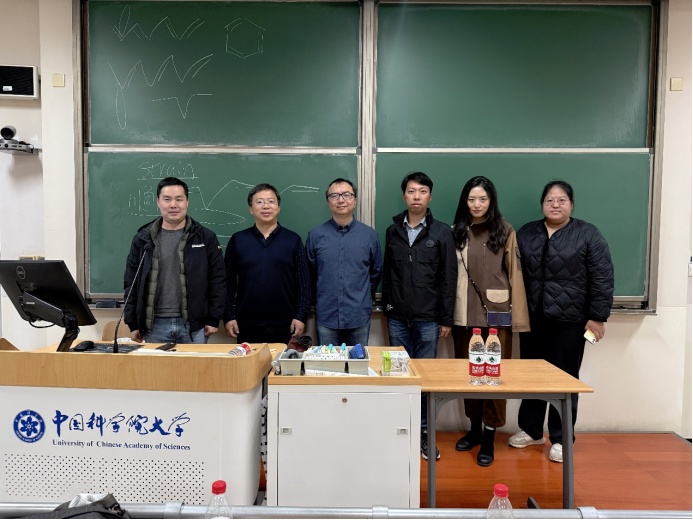
Lastly, Zhu Jia elaborated on the thermoelectric conversion mechanism and offered a vision for future thermoelectric technology, sparking great interest among the attending teachers and students, followed by a lively discussion.
-
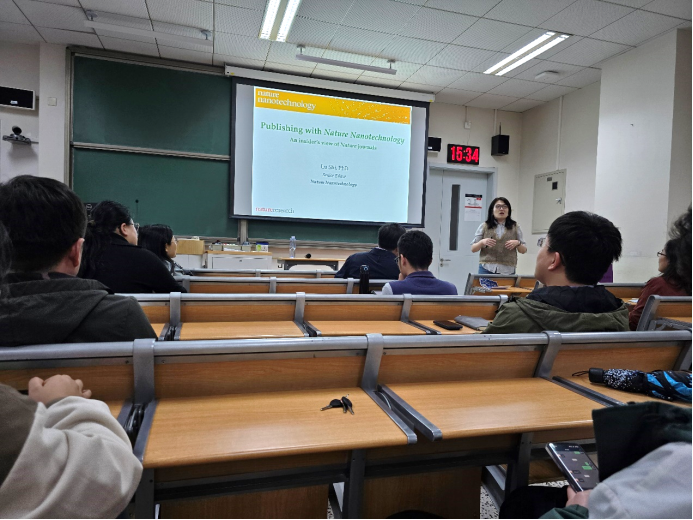 Senior Editor Lu Shi’s Lecture on “Publishing in Nature Nanotechnology: An Insider’s View of Nature Journals”
Senior Editor Lu Shi’s Lecture on “Publishing in Nature Nanotechnology: An Insider’s View of Nature Journals”On October 17, 2024, Dr. Lu Shi, Senior Editor of Nature Nanotechnology, was invited by Prof. Hui Huang of School of Materials Science and Optoelectronic Technology to give a lecture on “Publishing in Nature Nanotechnology: An insider’s view of the Nature journal” in Yanqihu Campus, University of Chinese Academy of Sciences.

Dr. Lu Shi joined Nature Nanotechnology in April 2023 from Wiley, where she was the Editor-in-Chief of Advanced Electronic Materials and Deputy Editor of Advanced Materials. Prior to her editorial career, she worked on 2D materials growth and magnetoelectric transport behavior of van der Waals heterostructures. For her work, she received a joint PhD in Materials Science and Physics from the Université Catholique de Louvain, Belgium and Université Grenoble Alpes, France. She obtained her BEng and MSc in Materials Science and Engineering from Shanghai Jiao Tong University and Shanghai Institute of Ceramics, Chinese Academy of Sciences.

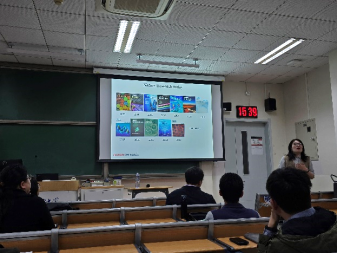
In the lecture, Dr. Lu Shi firstly introduced the history of the journal Nature and its research areas. Nature is a journal with significant influence and status in international science, and its research covers important research results in almost all fields of natural sciences, such as biology, chemistry, physics, astronomy and medicine. Its articles not only publish original research papers, but also include review articles, news reports, commentaries and opinions, etc., which play an important role in promoting the development of science and technology and facilitating global scientific exchanges.
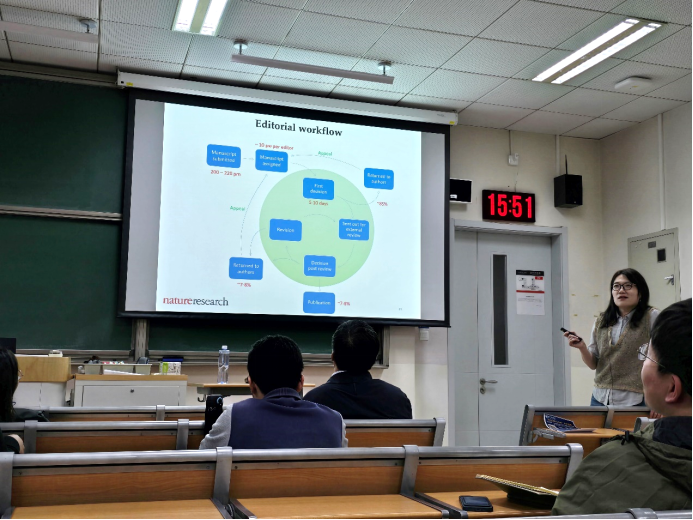
Dr. Lu Shi then talked about the workflow of Nature journal editors. As one of the most influential journals, Nature receives a large number of submissions every day. The editors review more than 10 articles per day, and after reviewing the articles for innovation and breakthroughs and taking into account the reviewers' comments, about 8% of the articles will be published in the journal.
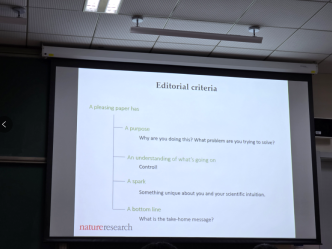
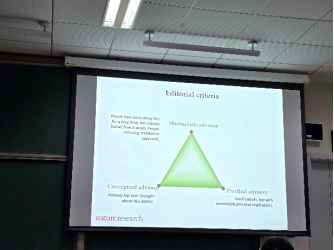
In addition, Dr. Lu Shi introduced that researchers’ work topics and article presentations should be closer to the apex of the “triangle” of advanced research mechanisms, advanced concepts, and advanced practical significance, which not only increases the appreciation of the article, but also greatly enhances the value of the research topic. A good research article should have a clear research background, research purpose, research highlights and future revelations.
-
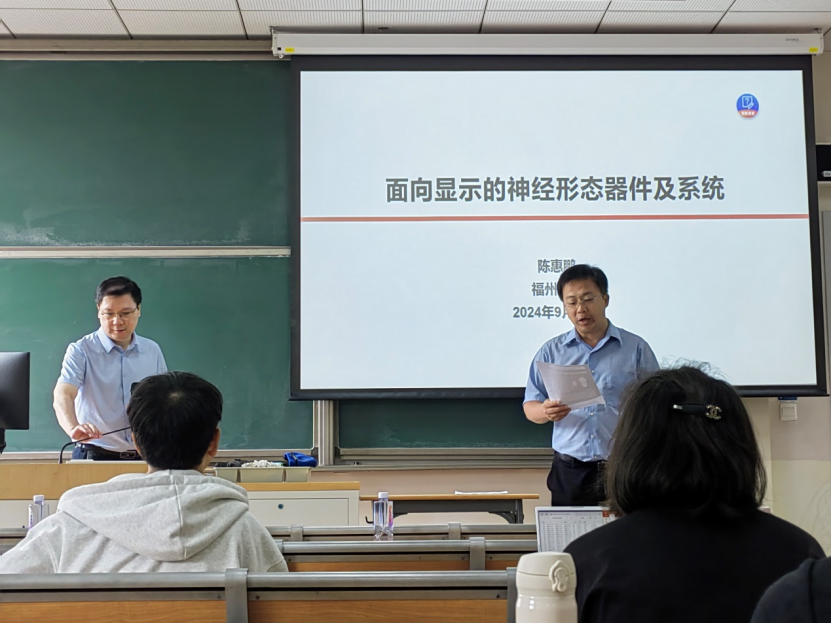 Professor Chen Huipeng gave a lecture on "Display-oriented Neuromorphic Devices and Systems".
Professor Chen Huipeng gave a lecture on "Display-oriented Neuromorphic Devices and Systems".On the morning of September 13, 2024, Professor Chen Huipeng from Fuzhou University was invited by Professor Huang Hui to give a lecture on the theme of "Display-oriented Neuromorphic Devices and Systems" at the University of Chinese Academy of Sciences, which was held in 214, Teaching Building 1.

This lecture first introduces the technical support of high-quality display images, high-frequency display drivers, and massive parallel computing in the future that will inevitably be inseparable from the needs of more realistic display experience, more frequent human-computer interaction, and larger data processing. Traditional display technology is facing the great challenges of high power consumption and low efficiency, and neuromorphic technology with the characteristics of integrated storage and computing can well solve these difficulties, so neuromorphic technology is an effective strategy to realize future intelligent display.
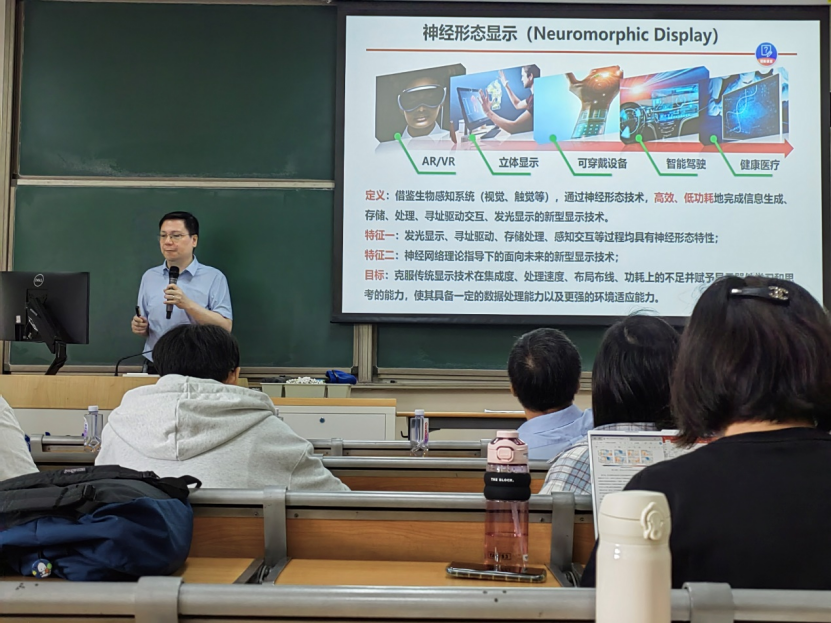
Then, the lecture introduced the specific work from four aspects: sensory memory and computing processing at the neuromorphic chip end, structural design of neuromorphic devices, neuromorphic light-emitting devices and neuromorphic display circuits, and pointed out that it is necessary to use the "top-down" idea to design neuromorphic devices and achieve simulation at the molecular level.
Finally, the lecture gave an outlook on neuromorphic display technology, and believed that the first stage of neuromorphic display development is to break the physical boundaries of storage, computing and display modules. The second stage is to integrate the functions of storage, calculation, and display on a single pixel.
At the end of the lecture, Mr. Chen discussed the problems of neuromorphic display at the device level, material level and mechanism level, and the lecture aroused heated discussions between teachers and students.

Chen Huipeng graduated from the University of Science and Technology of China in 2004 with a double bachelor's degree in applied physics and electronic information engineering. He graduated from Tufts University in United States in 2009 with a Ph.D. in physics. He is currently a professor and doctoral supervisor of Fuzhou University. He is a distinguished professor of Fujian Minjiang Scholars and a winner of the Fujian Outstanding Youth Fund. He has been engaged in the research of semiconductor optoelectronic materials and devices preparation and application for a long time. In the past 5 years, he has published more than 100 SCI papers in related high-level journals at home and abroad as the corresponding author in Nature Communications (7), Advanced Materials (5), IEEE EDL (15) and other related high-level journals at home and abroad. He has presided over the National Natural Science Foundation of China regional joint key projects, national key research and development projects, and general projects of the National Natural Science Foundation of China.
-
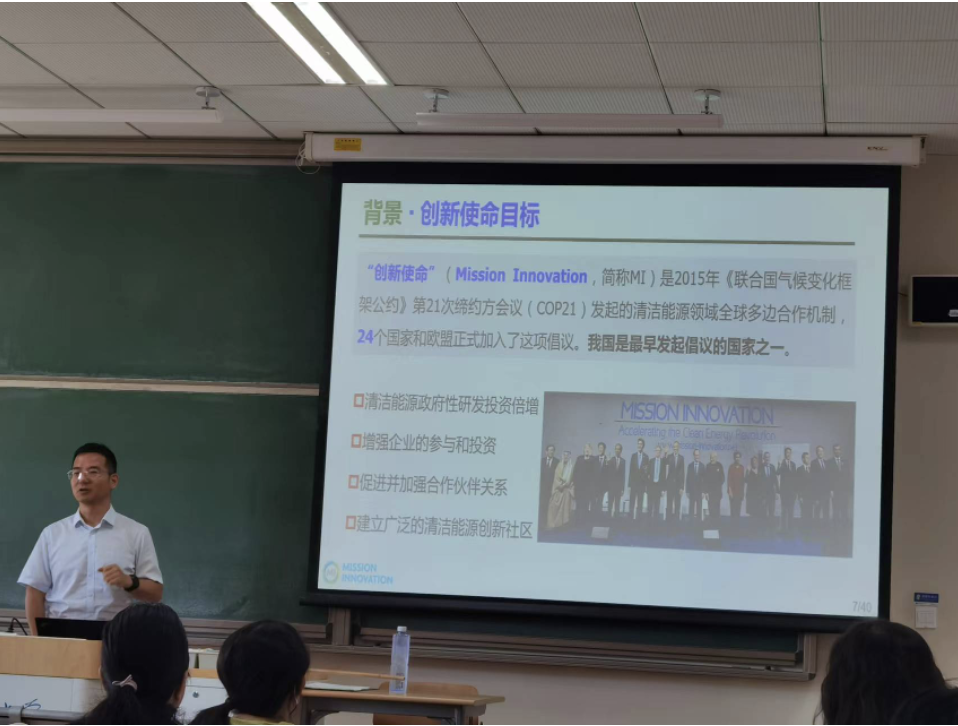 Prof. Wang Yibo gave a lecture on "Green Power Technology Innovation and Global Cooperation in response to climate Change"
Prof. Wang Yibo gave a lecture on "Green Power Technology Innovation and Global Cooperation in response to climate Change"On the morning of June 12, 2024, Wang Yibo, a researcher from the Institute of Electrical Engineering of the Chinese Academy of Sciences, was invited by Professor Huang Hui to give a lecture on the theme of "Green Power Technology Innovation and Global Cooperation in Response to Climate Change" at the University of the Chinese Academy of Sciences. The lecture was held in Room 215 of the first Teaching Building.

The burning of fossil fuels emits a large amount of CO2, leading to global warming. On December 12, 2015, the Paris Agreement was adopted at the 21st United Nations Climate Change Conference (Paris Climate Conference), aiming to limit the global average temperature rise to less than 2 degrees Celsius compared with the pre-industrial period, and strive to limit the temperature rise to less than 1.5 degrees Celsius. In recent years, it has received widespread attention around the world.


In the lecture, Wang Yibo briefly introduced several major sources of CO2 emissions, of which the energy sector accounts for about 85%, so to achieve the established goals of the Paris Agreement, it is necessary to achieve energy transformation and reduce the burning of fossil fuels. In 2015, the international community put forward the "Innovation Mission" initiative, and China was one of the first countries to launch the initiative. Wang Yibo clearly introduced the goals of the first phase (2015-2020) of the "Innovation Mission" : to double the government's scientific research investment in the field of clean energy, build a high-level international platform, and promote the development of clean energy innovation; The second phase (2021-2030) of the sixth Ministerial Conference on "Innovation Mission" issued the MI2.0 Innovation Declaration and two major innovation cooperation mechanisms "mission mechanism" and "innovation platform". After that, Wang Yibo spoke about three major challenges: Challenge 1: economical and reliable renewable energy generation technology; Challenge 2: Power system flexibility and market design; Challenge three: Power system integration, data and digitization. Then, researcher Wang Yibo introduced the next step of development ideas, in-depth international cooperation with developed countries, and the construction of a multilateral cooperation mechanism and platform of "self-oriented, for our use". At last, researcher Wang Yibo conducted exchanges and discussions with teachers and students on site, and received warm responses from teachers and students on site.
Dr. Wang Yibo is currently a researcher and doctoral supervisor at the Institute of Electrical Engineering, Chinese Academy of Sciences. He is also the leader of the "14th Five-Year Plan" renewable energy technology key special expert group of the Ministry of Science and Technology, the expert group of the smart grid Science and Technology Innovation 2030 major project of the Ministry of Science and Technology, and the secretary-general of the photoelectric special Committee of the Chinese Renewable Energy Society. Commissioned by the Ministry of Science and Technology in 2016, he established the Chinese Secretariat of "Innovation Mission" and served as the deputy director of the mission of "Green Power Future". In the past five years, he has presided over or participated in the preparation of more than 10 major consulting reports and held dozens of international conferences.
-
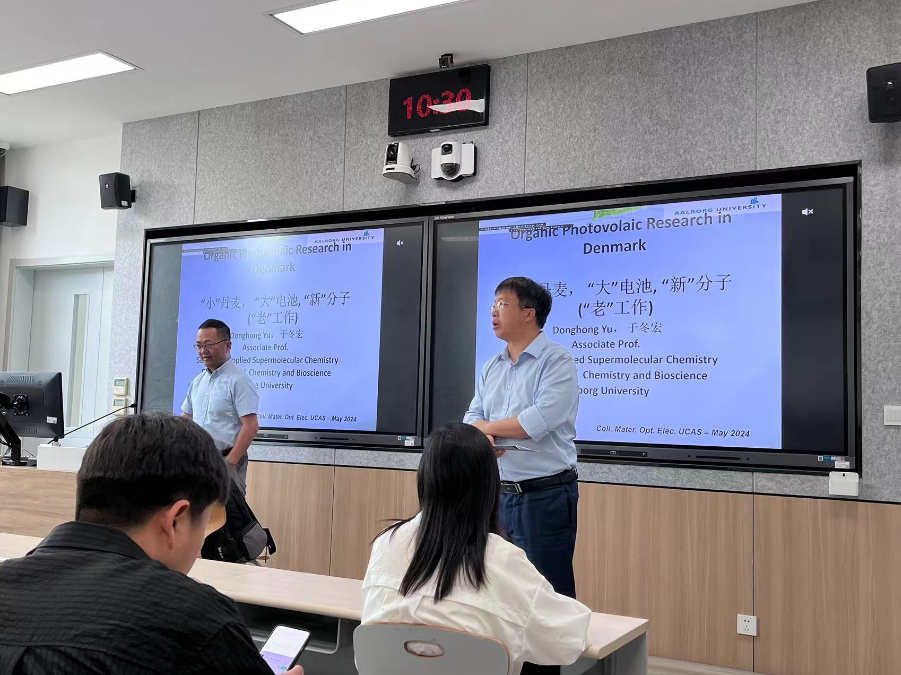 Professor Yu Donghong’s lecture on “‘Little’ Denmark, ‘Big’ Batteries, ‘New’ Molecules”
Professor Yu Donghong’s lecture on “‘Little’ Denmark, ‘Big’ Batteries, ‘New’ Molecules”On the morning of May 23, 2024, Professor Yu Donghong from Aalborg University in Denmark came to the University of Chinese Academy of Sciences at the invitation of Professor Huang Hui to give a lecture on the theme of "'Little' Denmark, 'Big' Batteries, 'New' Molecules". The lecture Located in Teaching One 115.


This lecture first introduces the scale-up synthesis experiment based on donor-acceptor polymer materials with reasonable molecular orbital energy levels, making it a continuous flow method with high molecular weight and constant mass, which can significantly increase the reaction rate and yield. The rate reaches the order of hundreds of grams per day.
Then, for traditional polyphenylene materials, we continued to use the fullerene acceptor system and applied roll-to-roll large-area rapid printing to create a large-area organic photovoltaic module composed of 40,000 single-junction cells, and at the same time generated electricity. Perform DC-AC conversion, simulate the grid input and output of energy, and ultimately reveal the possibility of organic photovoltaic power generation and transmission in the power grid in the future.
Finally, it will be explained that the traditional main chain skeleton conjugated donor/acceptor polymer materials cannot achieve ideal nanometer-sized self-assembly due to limitations of polymerization methods, which seriously affects the charge (carrier) separation and subsequent follow-up in photoexcitons transmission.
At the end of the lecture, Teacher Yu and everyone discussed the structural design and possible synthesis of new concepts of conjugated structure polymers. The lecture aroused heated discussion among teachers and classmates.
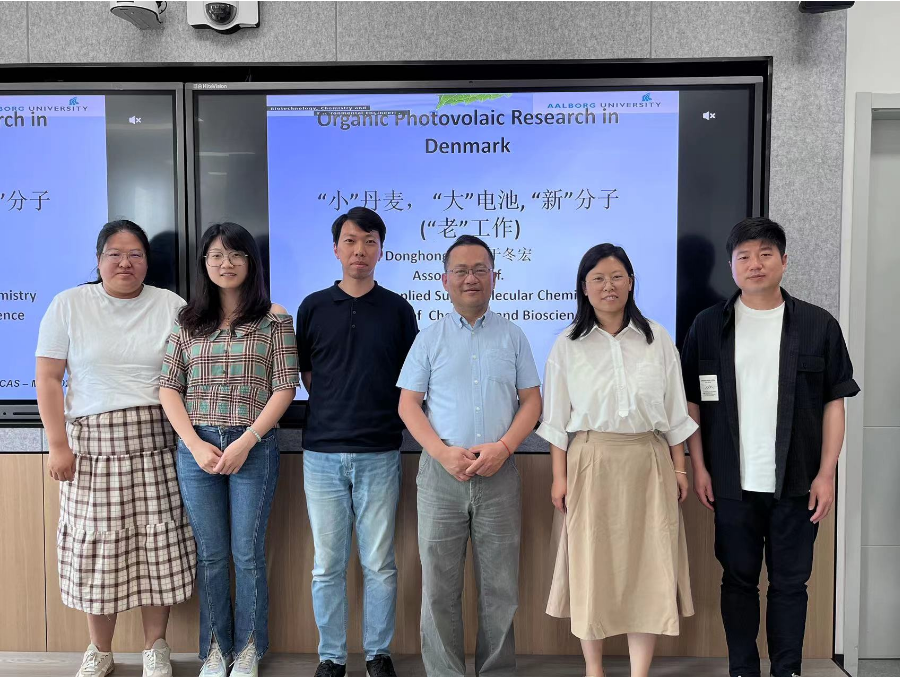
Professor Yu Donghong worked at the State Key Laboratory of Polymer Chemistry and Physics at Changchun Institute of Applied Chemistry, Chinese Academy of Sciences, the National Institute of Materials and Chemistry, Institute of Industrial Technology, Japan, and the Mechanics Department at Aalborg University, Denmark, from 1997 to 2006. He serves as an assistant professor, special research fellow, research assistant professor, and assistant professor in the Department of Engineering and the Department of Chemistry and Biological Sciences. From 2006 to the present, he is a tenured associate professor in the Department of Chemistry and Biological Sciences at Aalborg University, Denmark. Research areas include organic solar cell materials, polymer light-emitting diodes, molecularly imprinted polymers (molecular recognition, biosensing) and inorganic-organic nanohybrid biomaterials. It has successively undertaken funds from the Danish Ministry of Technology and Innovation, the Danish National Natural Science Foundation and the Danish National Strategic Research Fund, with a total scientific research funding of more than 20 million Danish kroner. He published 152 academic papers, which were cited 4030 times by him. In 2009, he won the Best Teacher Award from Aalborg University, Denmark.
